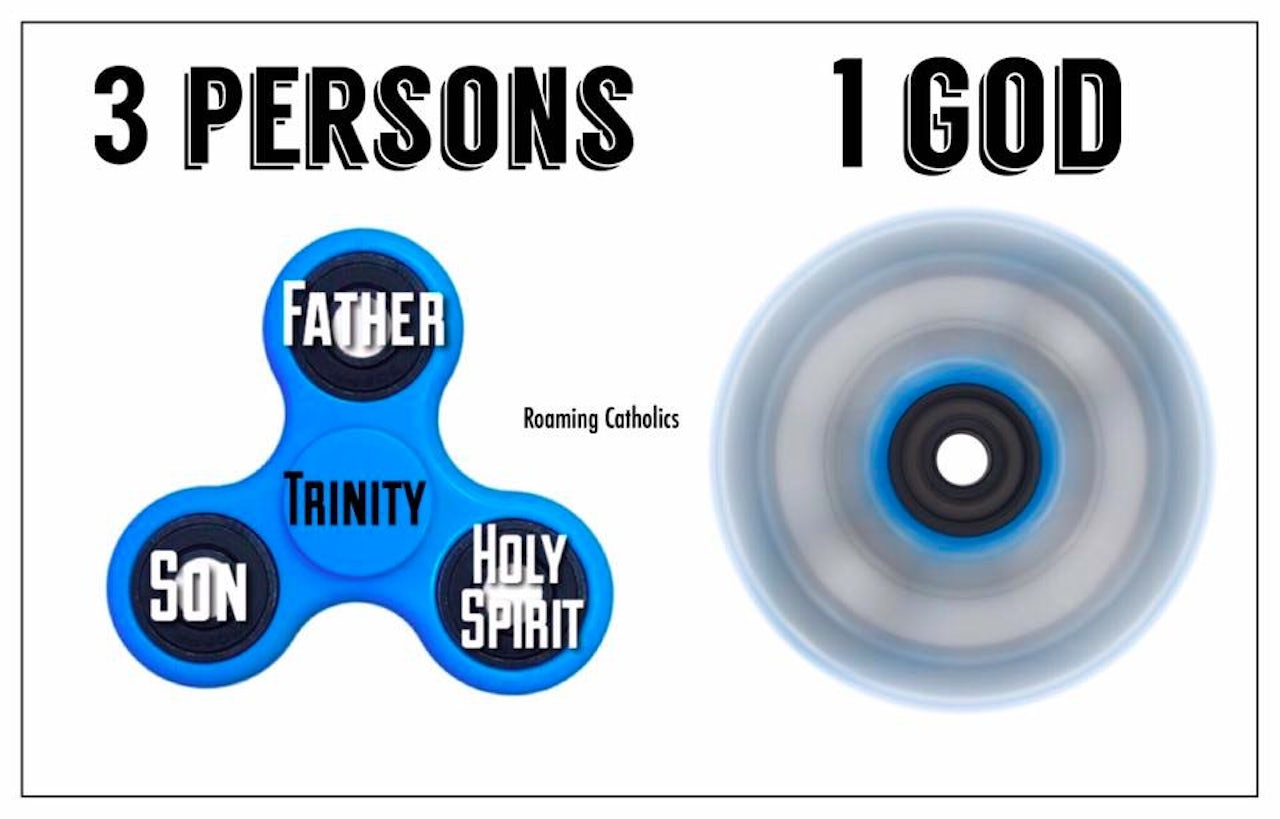I’m not Catholic, and much of my exposure to Catholicism begins and ends with pat, film-length characterizations of the religion. I had a vague idea of what the holy Trinity meant, and represented, but after days spent researching, it seems there isn’t much clarity. Even for people who’ve spent their whole lives steeped in the faith. “My grandparents never explained it in a satisfactory way,” one lapsed Catholic acquaintance recounted, “like, ‘three but one.’” Another added, “My mom told me the reason Catholics liked the Trinity so much was because they respected women. She later admitted she was lying.” A third asked, “Is this about fidget spinners?”
The unknowability of the holy Trinity is intentional: It’s one of the central mysteries of the Catholic faith. God is the father, the son, and the holy spirit, but exists as a single divine nature. It’s commonly expressed visually through a diagram known as the Shield of the Trinity, which illustrates that while the son, holy spirit, and the father are all God, they are distinct from one another. Different interpretations and methods of teaching the Trinity flirt with polytheism and heresy, but that hasn’t stopped a new trend from emerging in more progressive swathes of the faith: trying to teach kids about the holy Trinity using fidget spinners, the new, ubiquitous, and seemingly inventor-less toy that has seen recent explosive popularity.
In most of its variations, the fidget spinner is simple and relatively cheap: a weighted bearing surrounded by three (or four, or two, or whatever) spinning lobes. And it has innocently made its way into schools, offices, the White House, emerging first as a potential tool for dealing with ADHD and anxiety. The fidget spinner is also, apparently, cropping up in churches. Twitter users have been reporting the appearance of fidget spinners in their Sunday sermons, particularly on June 11, Trinity Sunday, a day devoted to the celebration of the holy Trinity. An illustrative meme from a popular Facebook group called Roaming Catholics, which has over 200,000 followers, has since made the rounds on both the earnest and ironic internets.
The post has been shared more than 10,000 times on Facebook and in the nearly 1,500 comments, a debate is raging over the trend. “I think the spinning is problematic, since it visually indicates a confusion of the persons, as though their oneness were blending, rather than perfect communion,” wrote one person by the name of John Covert. But many defenses of the Trinity-spinner analogy were posted, too. “I think it’s a great idea.. To those of you complaining that this isn’t entirely, 100% theologically accurate - of COURSE it’s not,” wrote Facebook user Colleen Ayers.
“To compare the Trinity to a fidget spinner (as with the shamrock) is to commit the heresy of partialism.” — Toy Adams
But the controversy over using fidget spinners to teach kids about the Trinity has spilled outside of the Roaming Catholics Facebook group. My favorite take, that fidget spinners are simply annoying, appears on the website for the Archdiocese of Baltimore, in the form of dueling op-ed poems. In “Lament of the Fidget Spinner,” Robyn Barberry complains about the annoyance of 2017’s response to the yo-yo, writing, “This obnoxious toy from 7/11 / Has nearly every kid in heaven / But as a teacher and as a mom / They’re getting in the way of my job!” Fellow poet Rita Buettner disagrees: “While teachers ban them by the score / The kids just master even more / Annoying? Spinners just might be / But no complaints will come from me.”
At the Catholic news site Crux, Father Jeffrey F. Kirby offers an argument (in prose) for the little spinning toys: “Believe it or not, the mania among young people these days over the fidget spinner can be an odd but very real call to prayer. As the person sees the need for mental rest … she can realize there are other broader and deeper resources for such renewal and rejuvenation.” Kirby avoids any theological projection onto the shape of the spinners. But at Unsettled Christianity, Toy Adams condemns the Trinity-as-spinner analogy on a more theological basis (“not to be a heresy hunter, but heresy is serious,” they write). “To compare the Trinity to a fidget spinner (as with the shamrock) is to commit the heresy of partialism, for it undercuts the full divinity of each person, so as to indicate that each are only one part of a three part God…The Trinity is a glorious mystery. Let’s let that be enough.”
A trendy, tactile plastic toy will not lead children to associate Catholicism with coolness
Catholicism is full of innumerable schisms, but the divide over dumbing down the Trinity to make it more easily digestible is a long-standing one. St. Patrick analogizing the Trinity to a shamrock (and also to water’s various chemical stages) has historically merited accusations of partialism (suggestions that God is composed of three parts) and heresy. Comparisons between fidget spinners and the shamrock came up frequently as I scoured Catholic message boards for this article. While some argue that the fidget’s spinning motion makes it a more effective illustrative tool, since it can “so perhaps better capture the dynamic movement, equality and relationality of the Godhead,” opposing contingencies maintain that “when you try to talk about God, you soon end up being a heretic.” The Archdiocese of New York did not respond to a request for comment.
Ultimately, the fidget spinner is a toy. It does not merit think pieces. It does not merit sermons. It does not merit The Atlantic’s characterization as “a rich, dense fossil of the immediate present.” It will not save the world, cure your ADHD, or explicate confusing theological concepts. A trendy, tactile plastic toy will not lead children to associate Catholicism with coolness, no matter how hard young, trendy priests may push. And it certainly won’t send anyone to hell.

